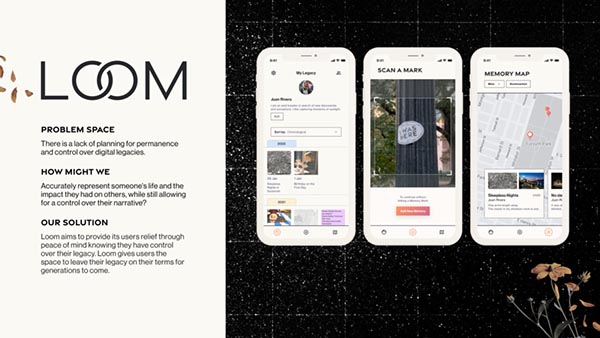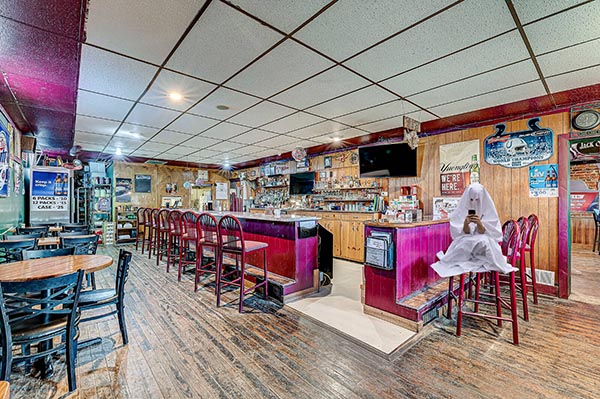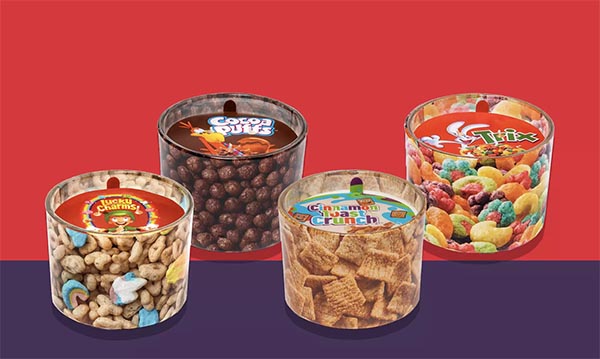More Core Competence
Two weeks ago, we highlighted the winners of the Core77 Design Awards in the category of “Visual Communication”which “honors all visual and graphic design, branding and identity projects for print, digital or physical environments. Examples include: logos and identity systems, environmental graphics, signage, typefaces, infographics, motion graphics, print design, advertising.”
There were more than a dozen notable mentions, one of which caught our attention: Loom, a project led by Angelia Gan, a student at the Savannah College of Art and Design. Basically, it is digital heirloom.
How long does our digital presence last? Accounts belonging to those who've passed don't get memorialized and are lost. These people's stories are left unfinished. Loom is a digital heirloom that can be passed down through generations to tell the story of a person's life and the impact they had on others. As legacies can hold deep value, Loom is respectful of each individual's terms and privacy levels. Loom serves to cultivate a culture of intention and meaning by preserving valuable memories and creating something that lasts.

Or, as a famous musical puts it, “who lives, who dies, who tells your story?”
Insultants
There is not a lot we can quote on this family-friendly site, but if you don’t mind some sweary words, check out this “Reddit chart of compound pejoratives.” From Boing Boing:
Colin Morris noted that on Reddit, a certain form of compound pejoratives—two words such as “buttface”, “shitlord”, “douchebag”—are found in diverse yet formulaic proliferation. So it’s time—with appropriate warnings about the presence of very offensive words—for some data science.
If you want to express your dislike for someone and a standard insult like “jerk” or “moron” won’t cut it, you can get creative. There are a few reliable recipes for forming derogatory noun-noun compounds in English. For example:
- Start with a word for a disgusting or worthless substance
- Add a word for an agglomeration or container
Hence, dirtwad, scumbag, pissbucket, snotwagon…
…Alternatively, -head, -face, and -brain(s) are incredibly versatile suffixes, which can be preceded by just about any taboo word.
The truly creative can go outside the box with oddball constructions like…
Ahem.
I collected lists of around 70 prefixes and 70 suffixes (collectively, “affixes”) that can be flexibly combined to form insulting compounds, based on a scan of Wiktionary’s English derogatory terms category. The terms covered a wide range of domains, including:
scatology (fart-, poop-)
political epithets (lib-, Trump-)
food (-waffle, -burger)
body parts (butt-, -face, -head, -brains)
gendered epithets (bitch-, -boy)
animals (dog-, -monkey)
If you like data analysis and swearing, click on through!
Two Steps Forward, Three Steps Back
Via Core77, Carlsberg is experimenting with a new kind of bottle made, not of glass, but wood fiber. The Fiber Bottlehas an outer shell made of “sustainably-sourced wood fibre,” but—uh oh—the inner liner (the thing that allows it to hold beer) is made of “plant-based PEF polymer lining, which has been developed by Carlsberg’s partner Avantium, a leading expert in renewable chemistry. PEF is made entirely from natural raw materials, is compatible with plastic recycling systems, and can degrade into nature should it end up outside national recycling systems.” Adds Core77: “Note that there are no details on the ‘degrade into nature’ bit; does it degrade into microplastics, or magically disappear?”
They also rightly point out that the best option is the refillable glass bottle or any glass bottle, which is completely recyclable—when anyone can be bothered to separate it properly.
Battery Bridge
Was it a good week for graphene news? It’s always a good week for graphene news! Researchers have come up with a use for discarded electric vehicle (EV) batteries: producing graphene oxide. Says Graphene-Info:
Emma Nehrenheim, Chief Environmental Officer of Northvolt, comments: “The upcycling of graphene oxide from recycled batteries represents a great development in our pursuit of a sustainable battery industry in Europe. Batteries contain an abundance of valuable materials which we can recover to reduce our dependence on mining and producing fresh materials. We are proud to have contributed to this development.”
…Graphmatech uses modified graphene oxide in materials and products it delivers to support the green transition, including hydrogen pressure vessels and pipes that leak 40% less hydrogen than current technology.
Alexa, Would You…Oh My God!!!!
We’re not sure about this…this is getting into some Black Mirror territory here. From The Verge:
Amazon has revealed an experimental Alexa feature that allows the AI assistant to mimic the voices of users’ dead relatives.
The company demoed the feature at its annual MARS conference, showing a video in which a child asks Alexa to read a bedtime story in the voice of his dead grandmother.
Ensuring that psychotherapy remains a lucrative profession for years to come.
“As you saw in this experience, instead of Alexa’s voice reading the book, it’s the kid’s grandma’s voice,” said Rohit Prasad, Amazon’s head scientist for Alexa AI. Prasad introduced the clip by saying that adding “human attributes” to AI systems was increasingly important “in these times of the ongoing pandemic, when so many of us have lost someone we love.”
“While AI can’t eliminate that pain of loss, it can definitely make their memories last,” said Prasad.
Amazon has not indicated that this will ever actually be made available, but it’s probably inevitable that it will creep into our lives.
Although this specific application is already controversial, with users on social media calling the feature “creepy” and a “monstrosity,” such AI voice mimicry has become increasingly common in recent years. These imitations are often known as “audio deepfakes” and are already regularly used in industries like podcasting, film and TV, and video games.
RecIPes
When family elders pass, they often take favorite recipes with them. One solution, via The New York Times, seems a bit like overkill (as it were): recipes carved on gravestones.
In cemeteries from Alaska to Israel, families have memorialized their loved ones with the deceased’s most cherished recipes carved in stone. These dishes — mostly desserts — give relatives a way to remember the sweet times and, they hope, bring some joy to visitors who discover them among the more traditional monuments.

Rachel Mummey for The New York Times
Naturally, TikTok has seized on the idea.
Recipes on gravestones are a relatively new phenomenon in the long history of cemetery iconography, he said. But they’ve found an ardent following online. On her TikTok channel, @ghostlyarchive, Rosie Grant shares headstone recipes, drawing hundreds of thousands of views from a devoted audience fascinated by the intersection of cemeteries and cooking.
Index cards would be a little less unwieldy, or the Loom app we mentioned earlier. Or someday you could have Alexa read the recipe in the voice of your grandmother.
Outside the Bun
Taco Bell recently launched a new high-tech drive-through weirdly called “Taco Bell Defy.” (Defy?) Introduced at the chain’s Brooklyn Park, Minn., location, you can place an order without ever having to interact with another human, or at least not directly. Says Gizmodo, you order via the Taco Bell App and,
after customers check-in at the drive-thru using their QR code, a cute little elevator will bring their food directly to their car window. It’s sort of like how a bank teller would send you money and checks at the bank drive-thru via tube, but instead it’s a Taco Bell employee sending you a Mexican Pizza and a Baja Blast all without you having to speak to anybody. Defy isn’t fully devoid of humans—Taco Bell says that one of the four lanes will allow customers to order from an actual person instead of a screen.
We’re not entirely certain this is the future of fast food, but say whatever you like about Taco Bell, they are particularly innovative, not just in delivery of food, but also in concocting bizarre things. Gizmodo also has a slide show of some of the more outlandish ideas the ’Bell has introduced over the years, including:
- An ill-advised (and we mean ill) partnership with Cheez-It that resulted in a tostada which swaps out a fried tortilla for a big Cheez-it and a Crunchwrap Supreme with a crunchy Cheez-It center.
- The Naked Chicken Chalupa that replaced fried flatbread with a fried piece of chicken.
- The Naked Chicken Chips: triangular-shaped chicken nuggets that you dip into cheese sauce. (Actually that doesn’t sound bad.)
- For Venn diagram lovers, the Triplelupa, or three conjoined Chalupas with overlapping flavors: cheesy, cheesy chipotle, and chipotle.
We’ll keep thinking inside the bun, thanks.
Bad Kitty!
Scientific American reports that the first case of a human catching COVID* from a cat has been confirmed.
A team in Thailand reports the first solid evidence of a pet cat infecting a person with SARS-CoV-2 — adding felines to the list of animals that can transmit the virus to people.
…Studies early in the pandemic found that cats shed infectious virus particles and can infect other cats. And over the course of the pandemic, countries have reported SARS-CoV-2 infections in dozens of pet cats. But establishing the direction of viral spread — from cat to person or from person to cat — is tricky. The Thai study “is an interesting case report, and a great example of what good contact tracing can do”, says Marion Koopmans, a virologist at the Erasmus University Medical Center in Rotterdam, the Netherlands.
They do point out that cat-to-human transmission is probably rare. Still, it’s worth being cautious if you’re around a possibly infected cat. Perhaps they sell little kitty face masks, although getting it on the cat may be a challenge, although less of one than on some humans.
*For those who may have forgotten, COVID-19 was a global pandemic that shut down essentially the world in 2020. Those few people you still see wearing masks in public? They’re trying not to catch it, which was a thing people used to do.
Beyond AirBnB
If your idea of luxury travel is staying in a giant, nuclear-powered “hotel airplane,” this demonstration animation is for you! Via Laughing Squid:
Engineer Hashem Al-Ghaili created an animation based on an original design by artist Tony Holstrem for Sky Cruise, a conceptual nuclear fusion-powered luxury hotel.
This high-flying hotel holds 5,000 people and stays in the air for years. The airborne hotel also has a shopping mall, elevators for easy access, and a deck for 360° views of the sky. The hotel is also equipped with an anti-turbulence system, state-of-the-art medical facilities, and is surprisingly, environmentally friendly.
How, dare we ask, is it environmentally friendly?
Its 20 electric engines are powered solely by clean nuclear energy. A small nuclear reactor uses highly controlled fusion reaction to provide the sky hotel with unlimited energy. Thanks to nuclear energy the hotel never runs out of fuel and can remain suspended in the air for several years without ever touching the ground.
To be honest, that’s less comforting than they think it is.
Sounds kind of terrifying.
Last Call
If you’re looking for a change of career and thought owning a bar would be a good option, there is one for sale in Indiana. One little hitch, though: the spirits are not just in bottles. Says Fox59: “Between Kokomo and Noblesville, you’ll find the little town of Kempton. In that little town of Kempton, you’ll find the Breeze In. And in the Breeze In, you’ll find some ghosts. At least that’s what the owners Cayenne Foutch and her sister Tara Fleming say.” They decided to put the bar up for sale and, when they told their realtor about the ghosts, it was decided to make it a selling point. They even made sure that all the photos on the listing page had ghosts in them—although some of them look a tad suspicious…

Alas, “He says the reaction has been great, but he has not received any solid offers so far.”
They’re asking $250K if anyone is interested. Tell them Around the Web sent you.
Now That’s a Rocket Launcher
Here are three words that would thrill any kid (or adult for that matter): Nerf rocket launcher. Via The Verge:
Preorders for the over 4-foot-long, 1:1 scale blaster began July 7th at 10AM PT / 1PM ET, and existing Gjallarhorn owners get dibs. If you’re looking to purchase the prop-grade Nerf LMTD blaster first, you needed to unlock it in-game in the Destiny 2 Bungie 30th Anniversary Pack before July 7th at 9AM PT before you can join the “virtual waiting room” for your purchase. So at the time we originally wrote this post, you had just over a week. If there are any left, Bungie will put them up for sale beginning July 21st.
OK, we understand very little in that paragraph, but, hey, Nerf rocket launcher!

Breakfast Club
Breakfast was always said to be the most important meal of the day, and if you were a kid, it could certainly be the most fun. And who doesn’t have a Proustian flashback at the scent of Lucky Charms? Well, now you can make your entire home evoke memories of a childhood breakfast, with these General Mills cereal-inspired candles. Via Food & Wine:
The collection is surprisingly robust, with 23 different options currently online — from 4-ounce candles for $5 each sold in what look like tiny creamer jars to larger 11-ounce one-wick and 12- and 13.5-ounce three-wick candles sold in a variety of packages for $10 a pop. Finally, Target has three gift sets, all for $15: two different three-packs of rectangular tins (one has Lucky Charms, Cocoa Puffs, and Cinnamon Toast Crunch while the other has Trix, Honey Nut Cheerios, and Lucky Charms) and a three-pack of traditional glass jar candles featuring mascots from Lucky Charms, Cinnamon Toast Crunch, and Honey Nut Cheerios.

Credit: Courtesy of General Mills
Where can one get them? Target—and they’re apparently quite popular.
A spokesperson for Target said that candles are the largest growing household item at the chain. And the candles section online includes 955 products, so they aren’t kidding. Additionally, cereal candles specifically appear to have an existing market: a search for “cereal candles” on Etsy brings up nearly 3,000 results — including plenty of knockoffs of the aforementioned brands. So this may be a bit of a “can’t beat ’em, join ’em” situation, too.
Go figure.
This Week in Printing, Publishing, and Media History
July 11
1804: He did not throw away his shot: U.S. Vice President Aaron Burr (spoiler alert) mortally wounds Alexander Hamilton in a duel.
1899: American essayist and journalist E. B. White born.
1927: American-Canadian physicist and engineer, inventor of the laser, Theodore Maiman born.
1960: To Kill a Mockingbird by Harper Lee is first published in the United States.
July 12
1493: Hartmann Schedel’s Nuremberg Chronicle, one of the best-documented early printed books, is published.
1580: The Ostrog Bible, one of the early printed Bibles in a Slavic language, is published.
1804: American general, economist, and politician, 1st United States Secretary of the Treasury Alexander Hamilton dies (b. 1755).
1817: American essayist, poet, and philosopher Henry David Thoreau born.
1854: George Eastman, founder of Eastman Kodak, born.
July 13
1793: Journalist and French revolutionary Jean-Paul Marat is assassinated in his bathtub by Charlotte Corday, a member of the opposing political faction.
1956: The Dartmouth workshop is the first conference on artificial intelligence.
1985: The Live Aid benefit concert takes place in London and Philadelphia, as well as other venues such as Moscow and Sydney.
July 14
1798: The Sedition Act becomes law in the United States making it a federal crime to write, publish, or utter false or malicious statements about the United States government.
1853: Opening of the first major US world’s fair, the Exhibition of the Industry of All Nations in New York City.
1910: American animator, director, producer, actor, and co-founder of Hanna-Barbera William Hanna born.
1912: American singer-songwriter and guitarist Woody Guthrie born.
1965: The Mariner 4 flyby of Mars takes the first close-up photos of another planet.
1974: British comedian David Mitchell born.
2015: NASA’s New Horizons probe performs the first flyby of Pluto, and thus completes the initial survey of the Solar System.
July 15
1606: Dutch painter and etcher Rembrandt van Rijn born.
1779: American author, poet, and educator Clement Clarke Moore born.
1799: The Rosetta Stone is found in the Egyptian village of Rosetta by French Captain Pierre-François Bouchard during Napoleon's Egyptian Campaign.
1930: Algerian-French philosopher and academic Jacques Derrida born.
1947: American singer-songwriter and musician Roky Erickson born.
1956: English singer-songwriter and guitarist Ian Curtis born.
2003: AOL Time Warner disbands Netscape. The Mozilla Foundation is established on the same day.
2006: Twitter is launched.
July 16
1661: The first banknotes in Europe are issued by the Swedish bank Stockholms Banco.
1862: American journalist and activist Ida B. Wells born.
1907: American farmer and businessman Orville Redenbacher popped out.
1935: The world’s first parking meter is installed in Oklahoma City, Oklahoma.
1956: American playwright and screenwriter Tony Kushner born.
1969: Apollo 11, the first mission to land astronauts on the Moon, is launched from the Kennedy Space Center at Cape Kennedy, Fla.
July 17
1717: King George I of Great Britain sails down the River Thames with a barge of 50 musicians, where George Frideric Handel’s Water Music is premiered.
1889: American lawyer, author, and creator of Perry Mason Erle Stanley Gardner born.
1902: Willis Carrier creates the first air conditioner in Buffalo, N.Y.
1954: American author, screenwriter, and producer J. Michael Straczynski born.
1955: Disneyland is dedicated and opened by Walt Disney in Anaheim, Calif.
2001: American publisher Katharine Graham dies (b. 1917).
2006: American crime novelist Mickey Spillane dies (b. 1918).















Discussion
Only verified members can comment.